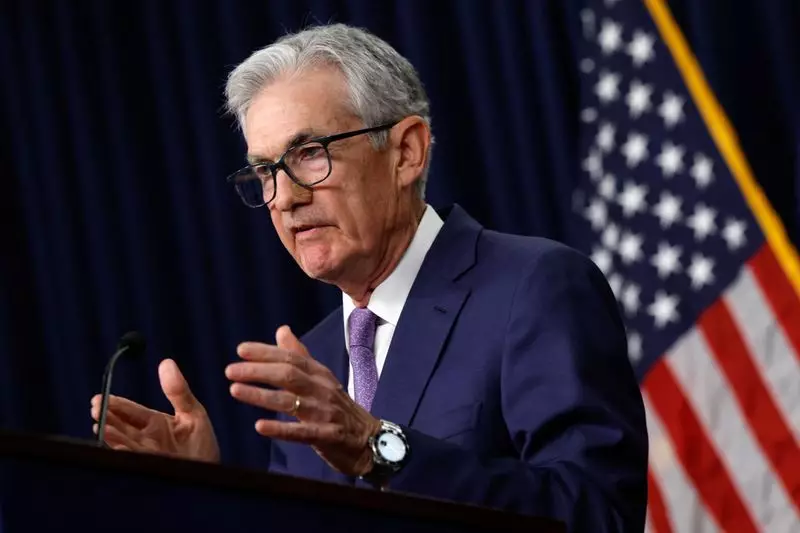As the Federal Reserve approaches 2025, Chair Jerome Powell finds himself in a precarious position, seeking to uphold the central bank’s independence while managing the potential repercussions of Donald Trump’s economic policies. This delicate navigation is not merely a bureaucratic challenge but an intricate dance of economic strategy and political perception. The Fed must navigate inflation forecasts and interest rate policies while maintaining its reputation as an apolitical entity, a task complicated by the shifting tides of U.S. political leadership.
At the core of Powell’s challenge is the Federal Reserve’s policy on speculation. In a recent address post-Trump’s election victory, he asserted a commitment to avoid assumptions regarding future policies’ effects on interest rates, stating, “We don’t guess, we don’t speculate, and we don’t assume.” This firm stance, however, contrasts starkly with recent actions and forecasts from the Fed, which have exhibited signs of a more hawkish approach. The reduction in interest rates—completed with a quarter-point cut—marks an adjustment in response to evolving inflationary pressures. Nevertheless, updated projections reflect a caution that belies previous assurances, with Fed officials now forecasting only two rate cuts for the coming year, a significant drop from four that had been anticipated just months prior.
Such a transformation in outlook, particularly the expectation that inflation may linger at 2.5% as opposed to a previously predicted 2.2%, reveals an underlying concern among Fed officials. Michael Gapen from Morgan Stanley highlights how the Fed’s recent meeting underscored this shift, noting that the policymakers seemingly reversed their initial refusal to engage in speculation about incoming policies. This inconsistency raises important questions about the Fed’s commitment to its core principles and the potential repercussions for its credibility.
The looming threat of Trump’s proposed economic strategies significantly impacts the Fed’s approach to monetary policy. His administration’s inclination towards tariffs and tighter immigration controls introduces a host of potential inflationary risks. Economic experts caution that such tariffs could elevate prices, while limitations in labor supply may exacerbate wage inflation. While Powell has made efforts to downplay the direct correlation between Trump’s policies and inflation predictions, attributing the Fed’s caution to recent inflation trends, critics point out the inherent political influences that shape economic decisions.
Furthermore, the necessity for Powell to expressly avoid public perceptions of political bias is evident. To maintain the Fed’s apolitical stance, he has reportedly advised colleagues to choose their words carefully. This strategy is crucial to uphold the Fed’s reputation as an entity driven by data rather than political whims. This tightrope walk is reminiscent of the Fed’s experiences during Trump’s first term when trade tensions necessitated a series of rate cuts due to rising economic instability.
Contrasting the current economic landscape with the conditions of 2018 offers insights into the Fed’s decision-making process. During Trump’s previous term, the backdrop was characterized by low inflation, allowing the Fed more flexibility in monetary policy. Now, however, Powell emphasizes a markedly different reality where inflation is already above targets, complicating the Fed’s responses to Trump’s potentially destabilizing economic agenda. This distinction is pivotal: it indicates that the methodologies of the past may not be applicable in the present landscape.
Powell’s perspective on tariffs and their effects highlights the Fed’s proactive stance in understanding new economic dynamics. His assertion that the Fed is scrutinizing how tariffs influence inflation represents a forward-looking approach, focused on crafting informed policy responses as the details of Trump’s plans come into sharper focus.
Diverging viewpoints persist regarding the potential ramifications of Trump’s administration on inflation. Supporters argue that increased deregulation and energy production will mitigate inflationary effects. On the contrary, many analysts express skepticism about the ability to offset these risks. The conflicting opinions underscore an unpredictable economic future, wherein businesses’ reactions to systemic changes, particularly regarding pricing, could further complicate the inflation narrative.
In a landscape of full employment, economist Ray Farris articulates the likelihood of businesses passing along cost increases to consumers, reflecting an inflationary environment that could become increasingly entrenched if wage pressures persist. The uncertainty surrounding corporate pricing strategies poses an additional layer of complexity for the Federal Reserve as it strives to adapt to evolving economic realities.
As the Federal Reserve grapples with the challenging interplay of political policy and economic fundamentals, the coming years may test its commitment to sound monetary policy. Chair Jerome Powell’s ability to balance these factors will be critical in navigating a potentially turbulent economic landscape marked by unprecedented political shifts. The Fed’s ongoing focus on data-driven decisions, coupled with an awareness of the political environment, will ultimately dictate its efficacy in managing inflation while upholding its stature as an independent institution. The journey to 2025 promises to be as complex as it is consequential, requiring both careful planning and an adept response to an ever-evolving economic scenario.

